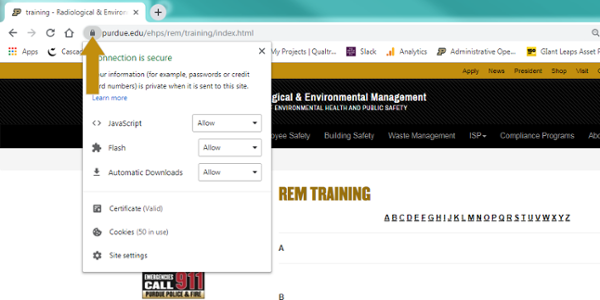Hazard Communication
The Hazard Communication Standard
The Hazard Communication Standard is an Occupational Safety and Health Administration (OSHA) regulation. The Hazard Communication Standard may also be referred to as the Right-to-Know Law, RTK, or HazCom. The citation number is 29 CFR 1910.1200. HazCom is a standard intended to protect employees from physical and health hazards that they work with or be exposed to in the workplace.
Document Link: Hazard Communication Written Compliance Manual
Designated Trained Individuals
Purdue University has an active Hazard Communication program that uses a train the trainer approach to meet compliance requirements. The program covers all employees of the University including full-time, part-time, temporary, and student employees that are NOT engaged in the laboratory use of chemicals.
Environmental Health and Safety (EHS) conducts the training for work area trainers. These trainers are known as designated trained individuals or DTIs. DTIs serve as the work area coordinators for HazCom including initial implementation and continued maintenance of the program in their work areas. Individuals that are to be the DTIs must attend a training/orientation session. The DTI training is a 30-45 minute course that covers the requirements of the Law, requirements of the University's program, an abbreviated review of Industrial Hygiene concepts, and a short example of how to establish the program in their work area. Hands on class exercises may also be used to demonstrate program requirements and concepts.
EHS conducts program audits annually to assess work area compliance through participation in the Integrated Safety Plan. For questions about the Hazard Communication Standard DTI Training contact EHS Industrial Hygiene.
Hazard Communication Training
The purpose of Hazard Communication training is to describe the hazardous characteristics and effects of chemicals and identify sources for chemical hazard information. Training includes a review of how chemical container labels and safety data sheets (SDS) present and format chemical hazard information since the updates mandated by OSHA for the Hazard Communication Standard in 2012.
Training Items Covered
- Chemical label elements (including pictogram, hazard statement, signal word, and precautionary statement)
- Information found in each section of the newly formatted SDS
- General chemical handling procedures
- Rule of thumb task specific chemical exposure controls
- Proper use of PPE and personal hygiene
- Emergency procedure for response to chemical contamination and spill cleanup
Online Secondary Label Training
To better protect workers who handle hazardous chemicals, OSHA has revised the Hazard Communication Standard. Online Secondary Label Training is provided to inform Purdue University employees of the updated OSHA hazard communication regulations and assist with compliance. These rules will bring the United States into alignment with the Globally Harmonized System of Classification and Labeling of Chemicals (GHS).
Hazard Communication Online Training Options
There are two (2) versions of online Hazard Communication training offered, awareness and comprehensive. The Hazard Communication Online Training Options table below provides links to both versions and guidance to help you determine which version you will need. The version you need is dependent on your exposure to hazardous chemicals. Initial training and retraining requirements along with job descriptions and work locations are provided to help you decide. These training courses meet the requirements of the OSHA Hazard Communication Standard. Upon completion your supervisor will show you where your department’s hazard assessment certifications and SDS’s are located. You will need your Purdue Career Account login and password to access the training. For questions about Hazard Communication Standard training contact EHS Industrial Hygiene.
For best results, use Internet Explorer to access the training.
| Links to Training | Awareness Training | Comprehensive Training |
|---|---|---|
|
Initial Training requirements |
Required when using chemical products per manufacturer’s intended purposes in amounts, extent, duration, and frequency commensurate with consumer use. |
Required when chemical use or exposure is a routine or significant part of the job and does not involve the "laboratory use of hazardous chemicals".* |
|
Retraining requirements |
|
|
| Job Descriptions, Work Locations, or Type of Work |
|
|
| Links to Training |
Note: You must enable Flash on your Chrome browser first. You do so by clicking the lock symbol to the left of the url. Set Flash to allow.

* Chemical Hygiene Plan Participation and Training
The Chemical Hygiene Plan (CHP) is required for the laboratory use of hazardous chemicals1. "Laboratory use of hazardous chemicals" means handling or use of such chemicals in which all of the following conditions are met:
- Chemical manipulations are carried out on a laboratory scale2
- Multiple chemical procedures or chemicals are used;
- The procedures involved are not part of a production process3, nor in any way simulate a production process; and
- "Protective laboratory practices and equipment"4 are available and in common use to minimize the potential for employee exposure to hazardous chemicals.
At Purdue University a principal investigator (PI) may have the option, after EHS consultation, to comply with the Hazard Communication Standard instead of the Chemical Hygiene Plan (CHP) when using hazardous chemicals in their laboratory. Be aware that Hazard Communication Program compliance has several additional mandates that CHP compliance does not. Examples include a designated trained individual (DTI) responsible for maintaining all program training records; chemical inventories; 24/7 centralized accessible SDS for all chemicals; and more stringent secondary container labeling (i.e., no chemical abbreviations or formulas). EHS will make the final determination.
Definitions: |
||||
|
|
1 Hazardous chemicals means any chemical which is classified as health hazard or simple asphyxiant in accordance with the Hazard Communication Standard (29 CFR 1910.1200). |
|||
Campus Safety Contacts

If you see something, say something.
Purdue Police
Phone: (765) 494-8221
Purdue Fire
Phone: (765) 494-6919
Sign up for Emergency Text Messages
Do you want to recognize one of our staff for a job well done? Nominate the staff member(s) for a Bravo Award here!

